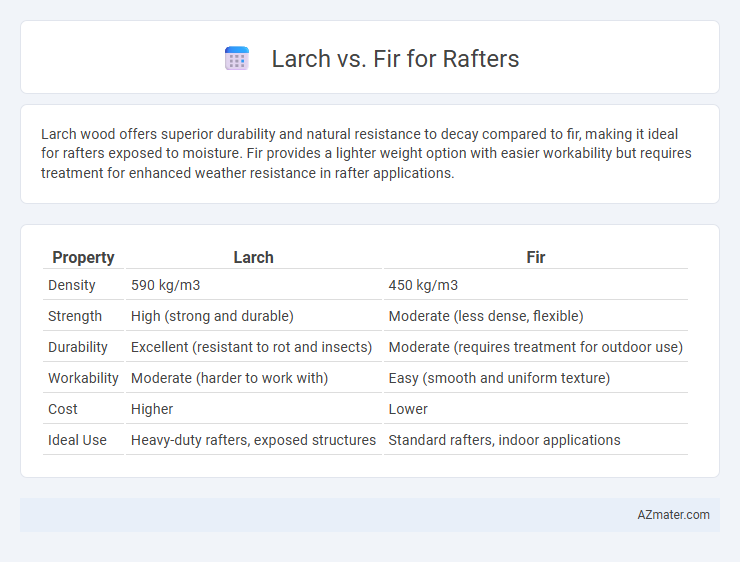Larch wood offers superior durability and natural resistance to decay compared to fir, making it ideal for rafters exposed to moisture. Fir provides a lighter weight option with easier workability but requires treatment for enhanced weather resistance in rafter applications.
Table of Comparison
| Property | Larch | Fir |
|---|---|---|
| Density | 590 kg/m3 | 450 kg/m3 |
| Strength | High (strong and durable) | Moderate (less dense, flexible) |
| Durability | Excellent (resistant to rot and insects) | Moderate (requires treatment for outdoor use) |
| Workability | Moderate (harder to work with) | Easy (smooth and uniform texture) |
| Cost | Higher | Lower |
| Ideal Use | Heavy-duty rafters, exposed structures | Standard rafters, indoor applications |
Introduction to Larch and Fir as Rafter Materials
Larch and fir are popular wood choices for rafters due to their strength and durability in structural applications. Larch is known for its high density and natural resistance to moisture and decay, making it ideal for roofing frameworks exposed to varying weather conditions. Fir offers a balance of lightweight strength and workability, commonly used in construction for its straight grain and uniform texture, ensuring reliable support in rafter systems.
Botanical and Structural Differences
Larch (Larix spp.) is a deciduous conifer known for its high resin content and natural durability, with a density ranging from 590 to 700 kg/m3, making it resistant to decay and ideal for rafter applications exposed to moisture. Fir (Abies spp.) is an evergreen conifer with a lower density of approximately 450 to 520 kg/m3, characterized by straight grain and softness that facilitate easier workability but offer less natural durability compared to larch. Structurally, larch provides superior strength and stiffness due to its tighter growth rings and resinous heartwood, whereas fir's lighter weight and uniform texture make it favorable for indoor rafter use where less environmental stress is expected.
Strength and Load-Bearing Capacity
Larch wood offers superior strength and high load-bearing capacity, making it an excellent choice for rafters in construction requiring durability and resistance to bending. Fir is also strong but generally has lower density and shear strength compared to larch, resulting in slightly reduced load-bearing performance. For applications demanding maximum structural integrity under heavy loads, larch rafters provide enhanced stability and longevity.
Durability and Resistance to Decay
Larch wood boasts excellent durability and natural resistance to decay, making it a preferred choice for rafters exposed to moisture. Fir, while structurally strong and lightweight, generally has moderate decay resistance and may require treatment for longevity in damp environments. The high resin content in larch contributes to its superior resistance against fungal attacks and insect damage compared to fir.
Workability and Ease of Installation
Larch offers excellent workability for rafters due to its moderate density and fine grain, allowing easier cutting, nailing, and shaping compared to fir. Fir is lighter and more uniform in texture, which simplifies handling and quick installation, especially for large-scale projects. Choosing larch improves durability with moderate effort, while fir ensures faster assembly with less resistance during installation.
Cost Comparison: Larch vs Fir
Larch rafters generally cost more than fir due to larch's greater density and durability, which enhances structural longevity and resistance to decay. Fir rafters are more budget-friendly, offering a lightweight and easy-to-work-with option ideal for cost-sensitive projects. Choosing between larch and fir involves balancing upfront material costs with long-term durability and maintenance expenses.
Availability and Sourcing Considerations
Larch wood is widely available in Europe and parts of Asia, making it a sustainable choice for rafters with regional sourcing reducing transportation costs. Fir, especially Douglas fir, is abundant in North America and commonly supplied through well-established lumber markets, ensuring consistent availability. Both woods vary in price depending on local demand and harvesting regulations, so sourcing decisions should factor in regional supply chains and environmental certifications.
Environmental Impact and Sustainability
Larch wood offers remarkable sustainability due to its fast growth and natural resistance to decay, reducing the need for chemical treatments in rafters. Fir, while commonly used in construction, often requires more intensive forestry practices and may involve longer growth cycles, impacting its environmental footprint. Choosing larch for rafters supports eco-friendly building by promoting renewable resource use and minimizing harmful environmental effects.
Aesthetic Qualities and Visual Appeal
Larch wood boasts a rich, warm tone with a prominent grain pattern that enhances the natural beauty of rafters, making it ideal for projects emphasizing rustic or traditional aesthetics. Fir offers a lighter color with a uniform texture, providing a clean, modern look that blends seamlessly with contemporary design schemes. Choosing between Larch and Fir for rafters depends on whether a project prioritizes the striking grain and earthy hues of Larch or the subtle, consistent appearance of Fir.
Which Wood is Better for Rafters?
Larch wood offers superior durability and natural resistance to moisture, making it an excellent choice for rafters exposed to harsh weather conditions. Fir, while easier to work with and more cost-effective, lacks the same level of rot resistance, which can compromise long-term structural integrity. For rafters requiring strength and longevity, larch is generally considered the better wood.

Infographic: Larch vs Fir for Rafter
 azmater.com
azmater.com